1.3.1.6.7.2.2 Edgar Franklin Kessler Jr. (b: 3 Dec 1924-d: 14 Apr 1978)
American Generation 7
Edgar Franklin Kessler, Jr. was my father. In relative terms, he lived a short life, passing at the age of 53. As a child of the depression and based on what I know of his childhood, he lived a difficult, “hardscrabble” life. He was born on December 3, 1925, just three years before the great Depression of 1929, which extended through the 1930s until World War II. These were Dad’s formative years, from young childhood through to adolescence.
Dad was the eldest of seven children and, as such, had to work to feed the family as a child when his father disappeared, as often happened. Dad told me that he set pins at a bowling alley in East Baltimore (before they had automatic pin setting machines bowling pins were reset by workers at the back of the alley). I can’t recall how much he earned but it couldn’t have been much in those days (1930s). When Dad was in the third grade he was hit by a vehicle and the impact partially crushed the front left forehead part of his skull. He had surgery to repair the damage and a metal plate inserted to if you look carefully at his photo, you can see the slight scar area.
After discharge from the hospital and during his recuperation at home, Dad was not required to attend school and in fact never returned. Effectively, he was a “third grade” dropout. He went to work as a young boy at a local bowling alley, setting pins. In the 1930s this was a manual operation requiring quick and deft hand action to clear and reset pins before another bowling ball came hurtling down the bowling lane. But Dad worked at this job for several years, giving the money that he made to his mother to buy food and pay bills.
As a result of this injury he suffered from epilepsy and took two medications: Dilantin and Phenobarbital (both are anticonvulsants). Throughout my entire life I would trek to the pharmacy and get Dad’s medications for him. During tough financial times he would ask me to go to the pharmacy and sort of “beg” for a few free pills until payday and I have to tell you that the pharmacists said very mean things to a young boy even though, for the most part, they would give the pills. Throughout my childhood Dad would experience sudden epileptic seizures and the family would have to grab him before he fell to the floor and try to gentle lay him down. We would put a cool wet cloth on his head and after a period of time his seizures would subside, but he would be exhausted from the event.
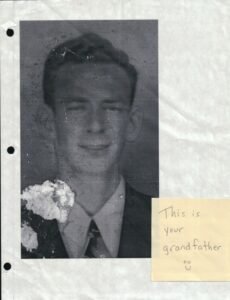
During World War II Dad enlisted in the U.S. Army (March 16, 1943). Although I cannot locate any information other than his Army enlistment record, I recall that he served long enough to earn veteran’s benefits. It is possible that his discharge was related to his epilepsy. While I am not sure of the sequence of events, I am certain of three things about Dad’s post-military time: 1) He attended art school (potentially this could have been prior to his service period), 2) He used the GI Bill to attend technical school (I faintly recall that he went to Lincoln Technical Institute, but I can’t be sure), and 3) He worked at Glenn L. Martin aircraft manufacturing plant in Essex, Maryland during the War. This is where he worked when he met Mom (Sue Kate Fairchild). They married on October 29, 1944.
Based on what he learned in electronics technical school, Dad became a television repairman. This was in the early days of television and well before color televisions were invented or sold (color television became popular during the early 1960s). Most electronics in those days used vacuum tubes in all major circuits and the most common electronic problem involved vacuum tube failure, so most of what Dad did was test and replace vacuum tubes, although he did often repair and solder other components including resistors and capacitors. He had a large carrying case for vacuum tubes, much like a toolbox, but a little larger. Dad often sent me to an electronics store on Baltimore Street (about a mile and half from home – and we walked everywhere in those days) to get a vacuum tube that he needed to repair a television.
In the early 1950s Dad obtained a job as a television repairman at the Lord Baltimore Hotel in downtown Baltimore, where he worked for 17 years. His job was to ensure that televisions were in good working order and were placed in hotel rooms. He also oversaw the radio room located on the third floor of the hotel, which consisted of a large patch panel that was used to control microphones and audio throughout the hotel. I often spent time with Dad in the radio room. The door to the room opened to a hallway and just across the hallway was a doorway to the balcony of the Ballroom and I spent a lot of time playing in the balcony. One evening Dad let me go with him and I watched a performance by Roy Rogers and Dale Evans, television performers from the late 1950s and early 1960s.
During his 17-year tenure at the Lord Baltimore Hotel Dad often wore white shirts, ties and suits to work. He really looked professional and dressed well for work. I clearly recall when Dad left his job at the Lord Baltimore. He decided to make a stand over salary with hotel officials. At the time he was making $100 per week, which was a reasonable salary at the time. However, he demanded a raise and threatened to quit if he did not get it. The Hotel called his bluff, threatening to turn over his operation to the Engineering Department and Dad quit. That was a major turning point in his life.
Dad tried to start his own business. He opened a television shop in a storefront located just off of Pratt Street on Payson Street. The store had previously been named Harry’s Shoe Store and when Dad rented it a lot of shoe display shelves and items were still in the store. It was a very curious thing to experience as a young man. Dad’s major problem as a businessman was that he had a big heart. He would spend time and his money on parts and repair customer televisions and radios, they would tell him a hard luck story, and he would then waive the charge, essentially making the repair for free. Clearly it did not take long for Dad’s shop to close.
At the time Mom was working as a glazer at Locke Insulator Company in South Baltimore. She worked on an assembly line, painting glaze onto ceramic power line insulators. She was very good at the job and made good money, since she was paid a piece-work rate. Every day, Mom would ride a bus downtown, transfer to another bus, put in a full day of work, ride two buses back home, and fix dinner when she got home. She worked at Locke for 26 years and many times was the main bread winner for the family.
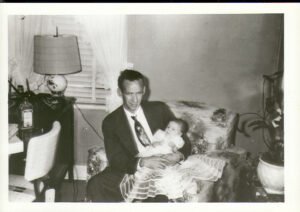
After leaving the Lord Baltimore and failing with his shop Dad struggled to find a job, eventually taking work with Midway Gas Station. His first station was located on Southwest Blvd, but he also rotated, filling in at various stations around the city, some in very bad neighborhoods. Eventually he became the primary operator at the Midway Station close to home, located at Monroe and McHenry Street where he worked until his death. Over the years he experienced a lot of events working at this station, including being robbed and shot at, helping people, and showing up, reliably, for his shifts. After he was robbed and shot at with a shotgun, he bought a 22-caliber pistol, which I still have in my possession.
Dad developed heart disease in 1978. He was hospitalized at University Hospital in downtown Baltimore (the same hospital where I was born) and sent home. He suffered an epileptic seizure, and his weakened heart could not withstand the strain, causing him to die of heart failure on April 14, 1978.
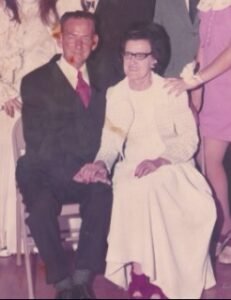
Since there are only a few of us alive who have memories of Dad, I offer a bit of insight into his nature and character. Despite lacking a substantive education, Dad was an intelligent, self-made man. During his years at the Lord Baltimore Hotel, he was able to dress well and interacted with people from all stations of life. He had a big heart and a great smile. He helped down and out people get kitchen jobs at the hotel, including an indigent slightly retarded man named Nick and his brother George (Bud) Kessler. He even helped my brother, Ed get a job as a room service delivery man at the Hotel before Ed joined the Navy.
Dad could lose his temper, at times. When he got angry, he would smack his hands together and curse. We would worry that these anger spells might trigger and epileptic seizure, which occurred sometimes. I will talk more about life at home in the next chapter.
My favorite memories with Dad include his making his famous “big breakfast” consisting of fried potatoes and eggs. Dad and Mom liked coffee. Dad liked his sweet without cream and Mom liked hers with cream but no sugar. They had a percolator coffee pot, and I have many fond memories of waking to the smell of coffee in the morning. We kids were forbidden to drink coffee as it was “not good for us.” Dad and Mom both smoked unfiltered cigarettes. They were raised in an era where smoking was promoted as “cool and trendy,” well before the health problems associated with smoking were raised to a high level of public awareness.
When Dad worked at the gas station at Monroe and McHenry Streets, I would often go up to Pratt Street to Martini’s Bar and get him a cup of coffee, which he really loved. I am not going to get into detail in this chapter about Dad’s drinking problems. I’ll cover that in detail in the next chapter as it really set the stage for the environment that we children experienced. But he did drink. He would get off work and go to a local tavern on Pratt Street named Bill’s Bar. Dad loved to play a game called shuffleboard and he was very good at it. Unfortunately, he spent a lot of money at Bill’s Bar, drinking and wagering on his games, and this left little money for saving or paying household expenses. The burden of keeping the family financially solvent fell to Mom. So that is a good transition into her story.
American Generation #7
Edgar Franklin Kessler, Jr., Wife and Children
| Edgar Franklin Kessler, Jr. | b: Dec. 3, 1924, Baltimore, Maryland d: Apr. 14, 1978, Baltimore, Maryland |
| Sue Kate Fairchild | b: Aug. 9, 1919, Asheville, North Carolina d: Aug. 16, 1986, Baltimore, Maryland |
Children
| Edgar Franklin Kessler, III (married JoAnne Popowski) (married Donna Faye Dabbs) |
b: May 26, 1947, Baltimore, Maryland d: Jun 10, 2009, Pearland, Houston, Texas |
| Thomas George Kessler (married Kathleen H. Mrozek) (married Patricia A. Kelley) |
b: Dec. 5, 1953, Baltimore, Maryland |
| Terry Lee Kessler (married Arthur Patton) (married Michael Doherty) |
b: May 8, 1958, Baltimore, Maryland |
| Bonnie Jean Kessler (married Joseph Sprinkel, Moises LaPlata, Kevin Bell and Merrill Nielsen) | b: Feb. 3, 1962, Baltimore, Maryland |
MATERNAL ANCESTRY: SUE KATE FAIRCHILD
Kate Fairchild. Mom was born on August 9, 1919, on a farm outside of Asheville, North Carolina in an area known as Mars Hill in Madison County. Her father was Robert Fairchild and her mother was Amanda Smith Fairchild (more about the Fairchild family history in a separate post). Mom was the youngest of six children. She lived in a typical early 20th Century tobacco farm environment, eating animals that were slaughtered on the farm, using an outhouse, having no electricity, and fetching water from a stream near the house. By the time I was old enough to learn about the North Carolina branch of the family the Fairchilds owned three farms on very hilly terrain in the Mars Hill area. Again, I’ll get into much more detail about the Fairchilds in a separate post or multiple posts devoted to family history and genealogy.
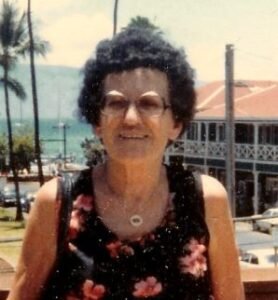
The relevant introductory part of Mom’s background is that she hated living on the farm, graduated from high school as the “girl most likely to succeed” and sold her pet hog to earn bus fare to Baltimore in the early years of World War II. She took a job at Glenn L. Martin aircraft manufacturing plant in East Baltimore and that was where she met Dad. I don’t know much about the romance or dating period, but clearly, they got married and started a family. Edgar F. Kessler III was born on May 25, 1947, Thomas G. Kessler (me) was born on December 5, 1953, a stillborn male was born sometime in 1954 (was to be named Ronnie), Terry Lee Kessler was born on May 8, 1957 (don’t let her tell you any different – that is the correct birth date), and Bonnie Jean Kessler was born on February 3, 1962.
Mom was a tiny woman, weighing something in the range of 90s to 100 pounds when she was not pregnant. She often told me that she wouldn’t eat chicken or meat because of the animals she saw slaughtered over the years on the farm, so she was essentially a vegetarian, even though she never referred to herself as one. After the war ended and Mom got laid off she eventually found a factory job at Locke Insulators, Inc. located at the Hanover Street Bridge between South Baltimore and the Fairfield community. Mom was not a driver. At one point she obtained a driver’s license, but she was reluctant to drive and never did. So, she took two buses to get to work – the #8 that she caught on Pratt Street and from there she transferred to the #10 running from Downtown to Brooklyn, Maryland. I can remember many a cold and snowy day when Mom took the buses to her factory job.
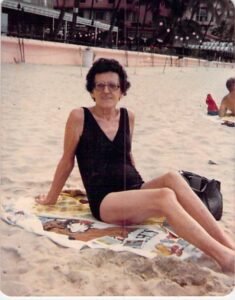
She was a glazier, using a brush to add glaze to ceramic insulators used in high-power lines. She worked “piece work” getting paid by the piece and this little tidbit makes for some interesting stories because Mom wanted to partner (the ladies worked in teams of two) with the fastest glaziers, even if she didn’t like them. Eventually, if I get back to this topic I’ll discuss the woman that she did not like as a person (I think her name was Sylvia) but who she always wanted to work with because she could make the most money. I believe that Mom worked for Locke (which was purchased by General Electric and then went back to being Locke later) for 25 years.
Mom worked at Locke/GE for 26 years before retiring. When Dad died in 1978, Mom and my sister Bonnie lived together on Lemmon Street in Baltimore. They then moved to the 2200 block of Wilkens Avenue and lived there until Mom’s death from emphysema in 1986. Mom and Dad are buried at Loudon Park Cemetery in Baltimore County, near the Wilkens Avenue side of the cemetery. They are buried with Jordan Patrick Sprinkel, Bonnie’s young son who died in an auto accident in July 1990.

Kessler Family – October 1973

Elizabeth Kessler with Grandchildren, May 1958 – Thomas Kessler, Terry Kessler (baby) and Edgar Kessler III

Sue Kate Fairchild Kessler

Edgar F. Kessler Jr.
